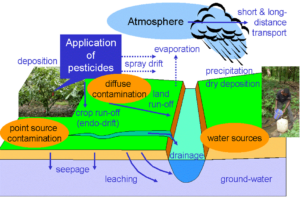About Lesson
Environmental Impact:
-
- Water Contamination: Pesticides can leach into soil and water, posing a risk to aquatic ecosystems. Runoff from agricultural fields may carry pesticides into nearby rivers and lakes, leading to water contamination. This contamination can harm aquatic organisms and disrupt entire ecosystems.
- Soil Health: Pesticides may affect soil health by altering microbial populations and nutrient cycling. Some pesticides can persist in the soil for extended periods, potentially leading to long-term environmental consequences.
- Impact on Non-Target Plants: Herbicides, designed to control weeds, may inadvertently harm non-target plants. This can affect biodiversity in agricultural landscapes and adjacent natural areas.
Potential Harm to Non-Target Organisms:
-
- Impact on Beneficial Insects: Pesticides, especially insecticides, may harm beneficial insects such as pollinators (bees, butterflies) and natural predators (ladybugs, spiders). Reduction in populations of these beneficial organisms can disrupt ecological balance and lead to increased pest pressures.
- Birds and Wildlife: Pesticides may have adverse effects on birds and wildlife that come into contact with treated areas. This can occur through ingestion of contaminated food sources or direct exposure to pesticides.
- Development of Pesticide Resistance: Over time, pests may develop resistance to certain pesticides, rendering them less effective. This can lead to a cycle of escalating pesticide use and the development of more resistant pest populations, posing long-term challenges for pest management.
Health Risks to Humans:
-
- Occupational Exposure: Individuals involved in the production, application, or handling of pesticides may face occupational exposure. This exposure can result in acute or chronic health effects, ranging from skin irritation and respiratory issues to more severe conditions.
- Residue in Food: Residues of pesticides may remain on treated crops and find their way into the food supply. Chronic exposure to low levels of pesticide residues in food has raised concerns about potential health risks, especially for vulnerable populations such as children and pregnant women.
- Airborne Drift: Pesticides applied as sprays or dust can drift through the air, affecting nearby communities. This airborne drift can lead to unintentional exposure to pesticides for individuals living or working in proximity to treated fields.

Image 2: Environmental contamination with pesticides
